Winter is around the corner which means, it’s time to start moving some plants back indoors! The key to a smooth transition lies in knowing the right time to bring them inside and how to do it without inviting bugs. Let’s break it down step-by-step!

Aphids, mealybugs, and other types of houseplant pests aren’t normally a problem outside. But they can quickly turn into a major infestation during the winter if they come inside on your houseplants.
When To Bring Plants Inside For The Winter
Knowing WHEN to start this process is key. You should start moving your plants inside during late summer or early fall, before nighttime temperatures consistently drop below 60°F (15.5°C). Exposing tender houseplants to temperatures below 50°F (10°C) can cause damage.
A good rule of thumb is to bring them in at least two weeks before your area’s average first frost date. For example, in zone 4, that’s September 20th, around the end of summer.
Waiting too long could shock your plants which can cause their leaves to drop, go dormant, or even die if frost hits unexpectedly.
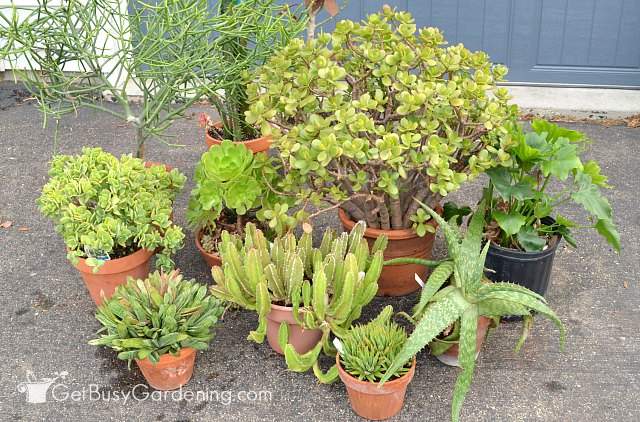
Amy’s Tip #1! 👩🏼🌾
Moving all your houseplants inside at once can be overwhelming, both for you and the plants. Instead, bring them in gradually over a few weeks. This way, you can manage the workload, and the plants can adjust more easily.

9 Steps To Debugging Your Plants
Debugging plants might sound complicated, but it’s actually straightforward. Here’s how to do it step-by-step:
Supplies You’ll Need:
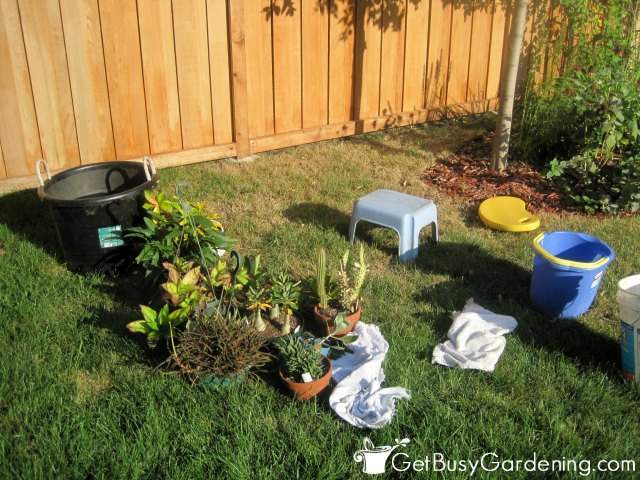
Steps:
- Fill the Tub with Soapy Water: Fill your large utility tub with tepid water, and your wash bucket with warm water. Add a few squirts of a mild liquid soap to each as you’re filling them. (Avoid soaps with degreasers or detergents, as they can harm plants.)
- Soak the Plants: Submerge each plant—pot and all—in the soapy water for 15-20 minutes. The soap kills bugs on the plant and in the soil. Weigh down any floating pots with bricks or rocks.
- Clean Any Exposed Leaves: Clean the leaves that aren’t submerged – If any of the leaves aren’t completely covered by the water, use an organic insecticidal soap to clean them. Or you can use my recipe, which is 1 teaspoon of mild liquid soap per 1 liter of water in a spray bottle.
- Remove Debris: Skim any dead leaves, bugs, or debris from the water using a kitchen strainer before pulling out the plants.
- Scrub the Pots: After soaking, scrub each pot clean with a brush.
- Rinse Thoroughly: Use a hose to rinse the plants and pots to remove any remaining soap and debris.
- Drain the Water: Allow the excess water to drain completely from the pots before bringing the plants indoors.
- Repeat as Needed: Continue the process until all your plants are debugged. Top off the water in the tub as needed and remove debris between batches.
- Move Plants Indoors: Once drained, bring your clean plants back inside and let the soil dry out before watering again.
Debugging Large Plants To Bring Indoors
Soaking houseplants in soapy water is great for small to medium sized potted plants, but I have several that are too large for this method. So, instead I use a modified version…
I wash the plant leaves and the stem of the entire plant with soapy water (using the same mild liquid soap I use for soaking plants), and then rinse it off thoroughly using the garden hose.
Once the leaves are clean, I spray the whole plant with neem oil and let it dry before I move it back inside.
NOTE: some houseplants are more sensitive than others, so be sure to test any type of spray on a few leaves before spraying the whole plant.
Amy’s Tip #2! 👩🏼🌾
If any of your plants are root-bound, repot them after debugging, before bringing them indoors. This keeps the mess outside and gives the plants room to grow.
3 To-Do’s AFTER Bringing Outdoor Plants Inside
- Increase Humidity: Many houseplants thrive in higher humidity. Use a portable humidifier indoors to maintain a humidity level around 50%, mimicking the plant’s outdoor environment.
- Inspect Regularly: Keep an eye out for pests after moving your plants inside. Early detection makes it easier to manage any outbreaks.
- Quarantine New Plants: If you’re bringing in new plants from outside or from a store, keep them isolated from your other houseplants for a few weeks to prevent spreading any hidden pests.
Benefits of Soaking Your Plants in Soapy Water
- Soaking gives your plants a thorough watering, so you don’t need to worry about it right away after bringing them inside.
- The process removes dead leaves and debris, leaving your plants looking fresh and clean.
- Your pots and plants will be sparkling clean, adding to the satisfaction of having healthy indoor plants.
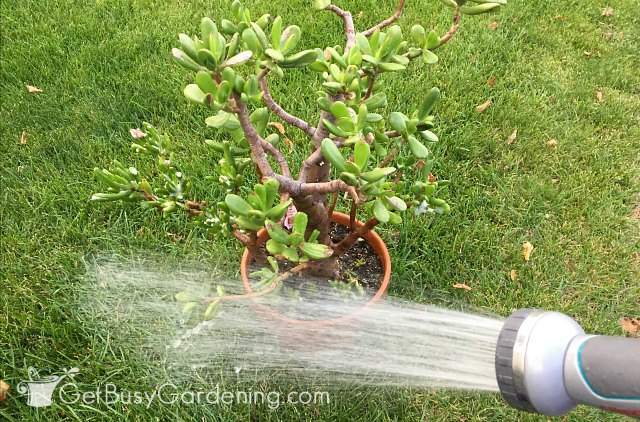
Related Post: Fall Houseplant Care Guide
Amy’s Tip #3! 👩🏼🌾
For large plants that are difficult to submerge, use a modified approach: Once clean, spray the entire plant with neem oil to deter pests (test a small area first to check for sensitivity). Wash the leaves and stems with soapy water, then rinse thoroughly with a garden hose.
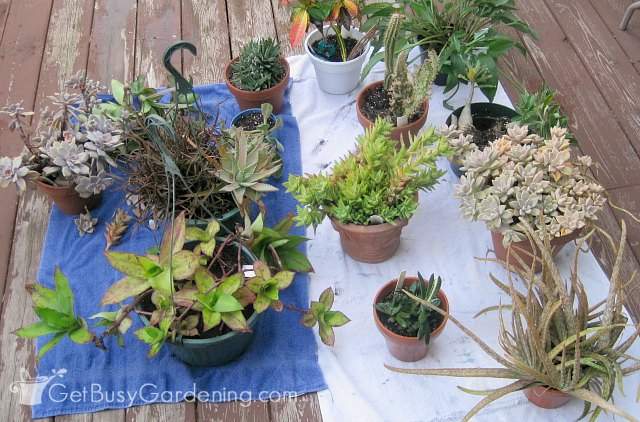
Debugging FAQs
What do I spray on plants before bringing them indoors?
You can spray your plants with a neem oil solution, or use an organic insecticidal soap to clean the leaves. I highly recommend testing any type of spray on a few leaves before treating the whole plant to make sure it won’t cause any damage.
Will your debugging method kill bugs and eggs in houseplant soil?
Yes, using my method to soak your plants in soapy water should kill any bugs or eggs that are living in the soil too. Sometimes there can be air pockets in the soil where they can survive though. So if you’re concerned, then soak them a little longer. Also, gently tap the pot after it has finished bubbling to try to release any trapped air.
How do you debug plants that are in pots without drainage holes?
To debug plants that are in pots without drainage holes you can wash the leaves with soapy water or insecticidal soap and rinse them off well after. Then spray the leaves with neem oil.
My method of soaking houseplants in soapy water works great for most types of plants, and will help to make sure you bring your outdoor plants inside without bugs. Trust me, starting the long winter off with clean and insect-free houseplants will make your life SO MUCH easier.
If you’re looking for more help for how to keep bugs off plants, my Houseplant Pest Control eBook is an essential guide to help you debug your houseplants for good. Download your copy today!
More Posts About Houseplant Pest Control
- Where Do Houseplant Pests Come From?
- How To Use Neem Oil Insecticide On Plants
- How To Get Rid Of Bugs On Your Houseplants
- Fungus Gnats vs Fruit Flies: What’s The Difference?
- How To Keep Cats Out Of Houseplants
How do you debug plants before bringing them in for the winter? Share your tips in the comments section below.


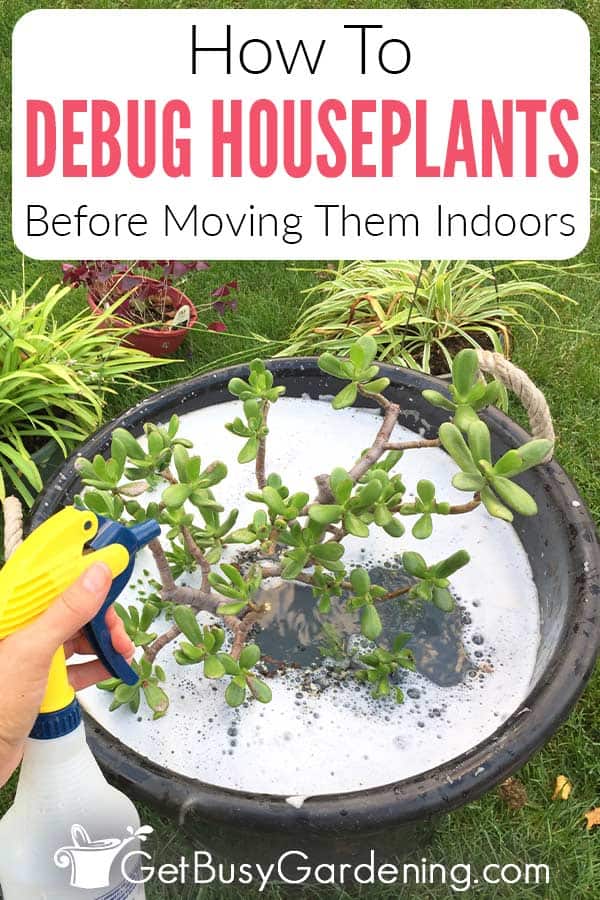
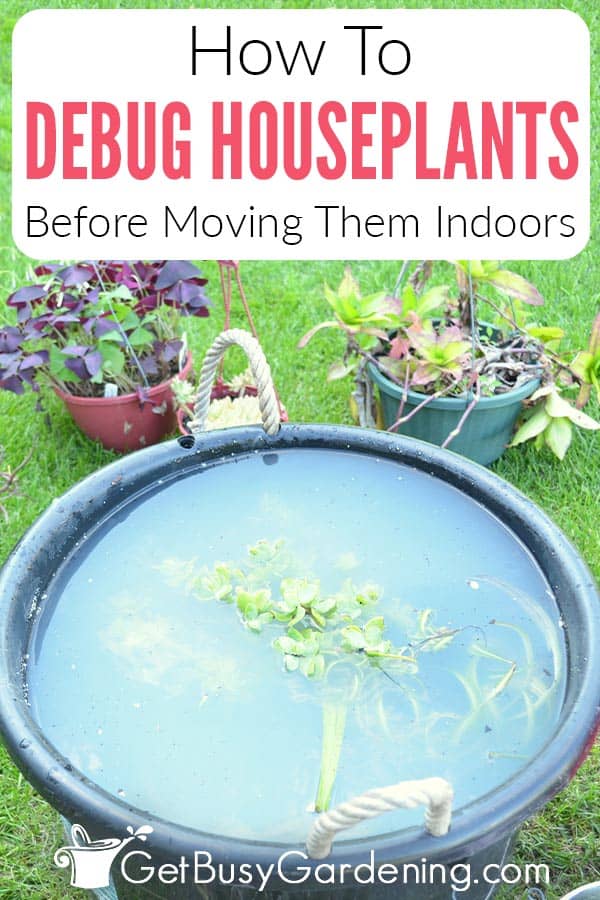
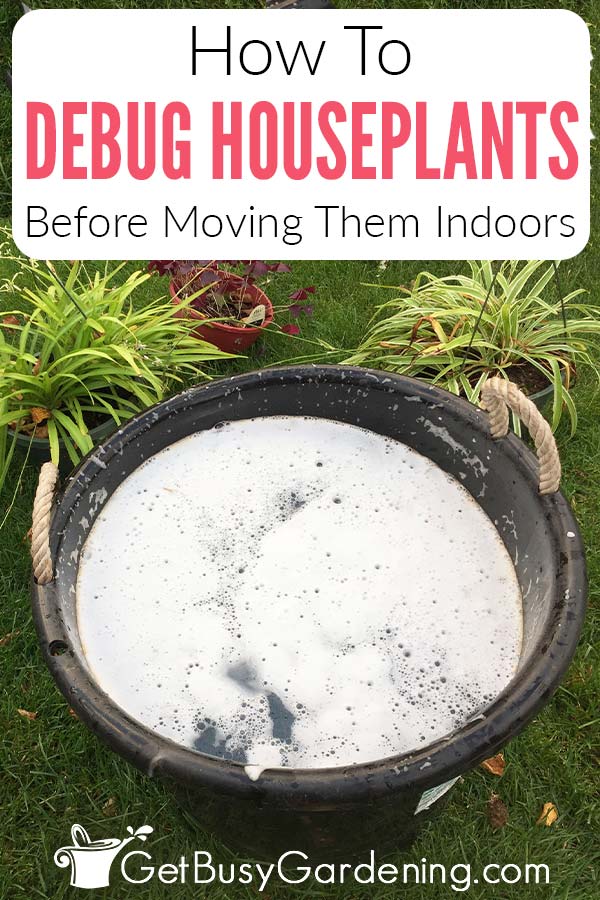
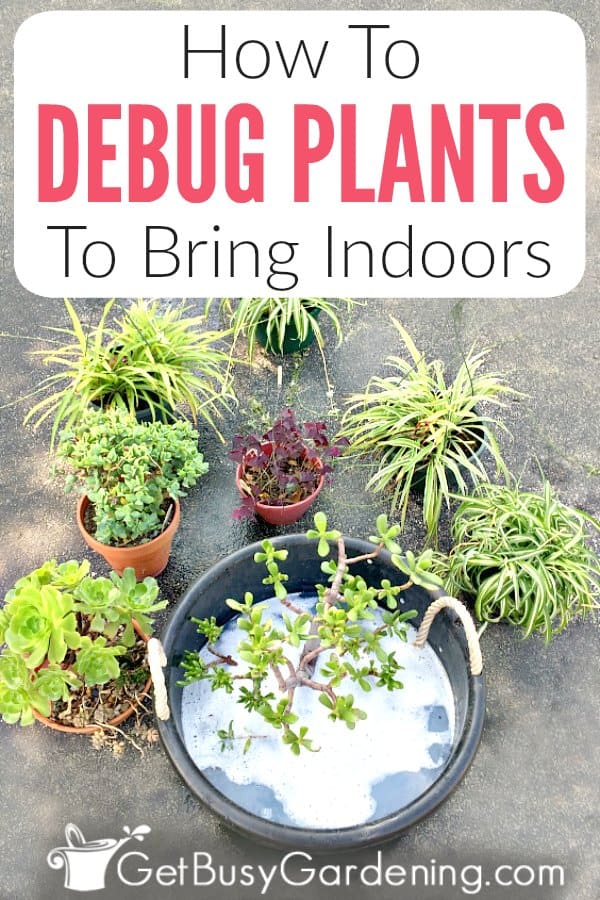
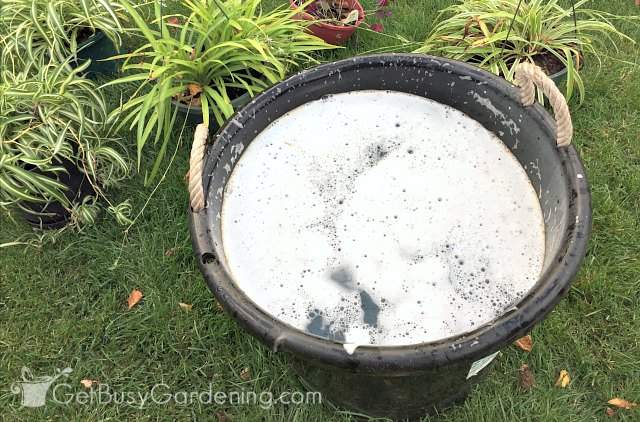
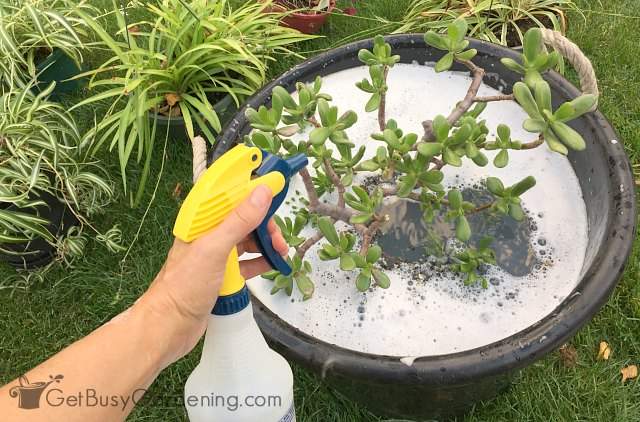
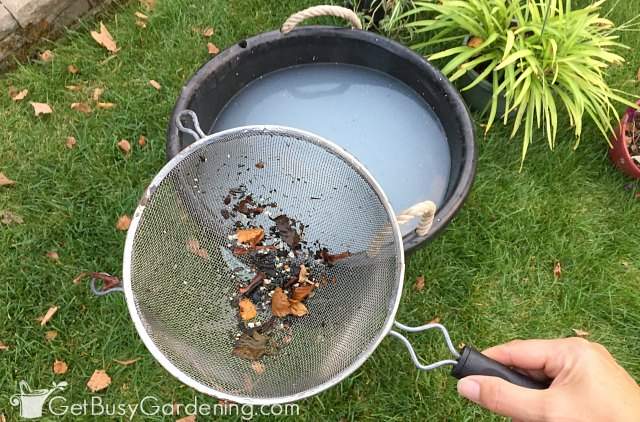
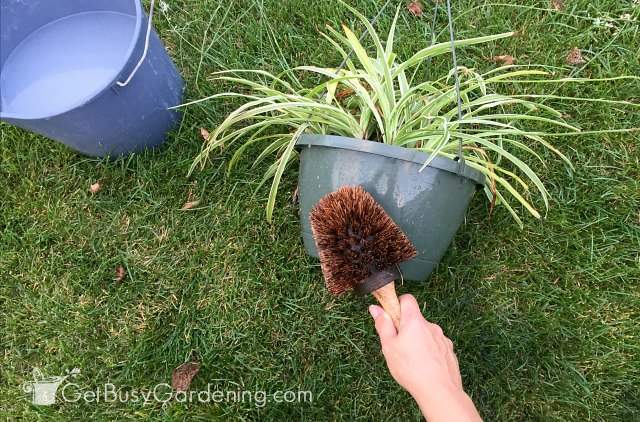
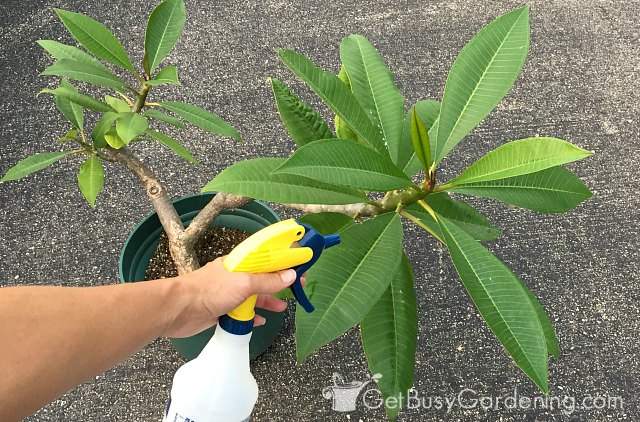
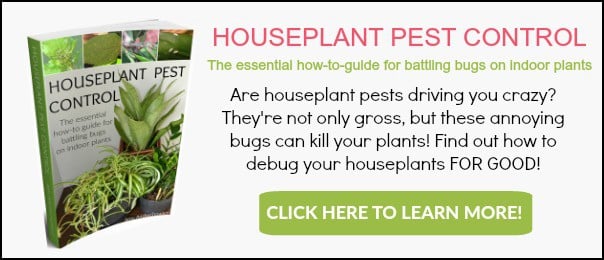


carol says
It is SO important to do this. Nothing is worse than finding hundreds of baby grasshoppers have hatched inside your house!
Amy Andrychowicz says
Oh my, yuck!! That sounds terrible.
Cotina Marshall says
I have referred to this post for the past several years and to date, no pests over the winter!
Amy Andrychowicz says
Yay, I’m so glad to hear that my method has worked for you to keep your indoor plants bug-free over winter! I do this every fall too. 🙂
Monique says
My plants are on a balcony it’s hard to soak in tub. Could I water lots with soapy water. Someone told me to cover with garbage bag also
Amy Andrychowicz says
Ooo, definitely don’t cover them with a garbage bag, that could damage them very quickly if they get too hot or don’t have adequate airflow. Watering them with soapy water may get rid of the bugs in the soil, but it won’t get rid of any on the leaves. I recommend following the directions I have under the “Debugging Large Plants” section in the article if you’re not able to soak yours.
Janie says
thank you for the great information, do you have any suggestions for how to do indoor lighting to keep hibiscus plants blooming through the winter
Amy Andrychowicz says
They actually do really well in a sunny south-facing window, mine blooms all winter there. Otherwise, you could add a basic grow light, and keep it on for 12-16 hours/day. Here’s my complete guide for how to overwinter hibiscus plants for more details.
Eileen says
I don’t have a large bucket like that. If I get one, I still can’t fill it with a hose. I live in an apartment and would not be able to fill the bucket with a hose or rinse the plants with a hose. Do you have any tips for those steps?
Amy Andrychowicz says
Follow the steps I outlined in the section about debugging larger plants if you can’t soak yours.
Lil says
you can use a large storage bin, drain them and riinse them in the sink or tub.
Judy says
Try the bath tub. Easy to fill, easy to drain, easy to clean and disinfect.
New to this says
Will soaking dissolve all the soil from the pot into muddy water, and will have to repot with all new soil
Tx
Amy Andrychowicz says
If your plants have been in their pots for a while, then no, the soil will not float to the top. Just leaves and other small debris will float out, which is nice because it helps clean the plants and pots. However, if it’s a plant that you just repotted, then yes, the soil could float out.
New to this says
Thanks! I will try this 🙂
Amy Andrychowicz says
You’re welcome!
Anita R Oortwyn says
Can I use the soap water that I made and spray it on the plant when it is indoors for the winter if I see bugs on it ?
Amy Andrychowicz says
Yes, you can use the same sprays I recommend in this article to treat you plants once they’re indoors because they are organic. Here’s a detailed article that will help you out… How To Get Rid Of Bugs On Houseplants.
Kim R says
Thank you for giving me the courage to submerge my succulents for so long. I was using less adequate means before. Flies, ants and aphids are no fun in the house!
I’m halfway through this year’s “Bring Them In” project. Thanks to the sudden generation of a green thumb after 40 years of killing the majority of my summer accumulations, I have more than 90 pots, mostly containing propagated succulents only a few month old.
I’m allergic to Neem oil, unfortunately. For my soap I use Murphy Oil, 1 tbsp to 1 gallon of water. It doesn’t harm the succulents, begonias, or even my orchids. It has no real effect on spiders or worms, but seems to work on the ants, aphids, etc. Or at least they float to the surface, and I don’t seem to have a problem in the house during the winter. This is the third year I’ve used it. I may try the Bronner’s next time.
All the babies are done and indoors. Most have enough of a root system to survive being soaked. The next stage is the giant, established plants; in particular about 30 Queen of the Night cereus plants that went nuts over the summer, having just reached maturity. For the largest, I’m hoping that pouring the solution through the pots several times and washing the leaves will be sufficient.
Amy Andrychowicz says
You’re welcome, happy to help! It’s a lot of work to bring all of those houseplants indoors, but totally worth it! The process of cleaning and debugging them takes me several weekends every year, but I would never skip these steps because I’ve spent full winters fighting houseplant pest infestations before, and that is SO MUCH MORE work and stress than taking the time to clean them in the fall! 🙂 Good luck.
Kim R says
*** Murphy Oil Soap seems to have changed its formula. The product I used the last few years was a dark honey brown and very thick. The product I bought this year under the same label was yellow and thinner, more the color of a healthy urine sample.
The new stuff does not kill anything! Pill bugs, slugs, spiders, etc. were still happily ensconced in their chosen pots, even after the full treatment.
This year I switched to Dr. Bronner’s unscented Castile soap (light blue label says “baby”).
Sigh. Doing the final 27 plants today!
Amy Andrychowicz says
Good to know, thanks for sharing your experience with trying to use Murphy oil instead of neem oil. Bummer to hear that it didn’t work for you though. 🙁 But the soap and soaking the plants alone should be enough to kill the bugs, especially ones that are on the plant itself. If you still have bugs that survive the process, then try adding more soap to your water and also soak the plants longer to drown any hiding bugs.
Kim R says
Before I started treating my plants prior to bringing them in, I was losing a battle against house flies. I live near a farm, and the barn cats like to leave offerings in my yard, so they’re always a few of the buggers infiltrating the house. But now that they’re not hatching out of my plant soil in winter, it’s a manageable issue instead of a a horror show.
Amy Andrychowicz says
Wonderful! So happy to hear that going through these steps to treat you plants before bringing them indoors has gotten rid of your fly problem, that’s fantastic news!
Beth says
Is Johnson Baby Shampoo ok to clean and debug my plants?
I am curious to see if all the dirt floats up to the top when submerged. Hope not!
Very interesting and helpful article!
Amy Andrychowicz says
I’ve never tried that brand of soap, so you should definitely test it on a few leaves and leave it for a couple of days to make sure it doesn’t cause any damage before submerging your plant. The soil won’t float to the top as long as your plant hasn’t been recently repotted.
Shelley Tanner says
I have a large pot of succulent plants that I want to transplant into their own pots before I bring them in. The pot they are in is too heavy & large to submerge. Should I transplant them first & then treat, or treat & then transplant?
Amy Andrychowicz says
I would treat and then transplant. If you try soaking newly potted plants, the soil will likely just float to the top and make a mess.
Deebs says
I’m new to gardening and only have a few plants to bring indoors, can I just replace the soil and pots, then rinse the plants with plain water? (If not, is handsoap ok to use?)
Amy Andrychowicz says
There’s no reason to repot all of your plants before bringing them indoors, using my debugging method would definitely be much easier (and less expensive). Also, simply rinsing the leaves with water won’t get rid of the bugs, you definitely need to use either neem oil or insecticidal soap to wash the leaves, as I explain in the article. Soaps are all very different, so you’ll need to test the one you have on a few leaves before treating the whole plant to know for sure if it is safe to use.
Sue Ferrentino says
Hi, good advice. I’ve had problems with little flies when bringing in my house plants. So i bought Tangle trap sticky coating . I take straws coat a thin layer of tangle trap and stick the straws upright in pots. within days they disappear . Then you just pull out straws and discard.
Amy Andrychowicz says
Great, thanks for sharing your tip for getting rid of the bugs before you bring your houseplants inside.
Natalie says
What are your thoughts on Castile soap?
Amy Andrychowicz says
That is the type of soap that I use and recommend in this article. Specifically Dr. Bronner’s Baby Mild, because it’s organic and doesn’t have any added essential oils. Whatever brand of soap you choose, always be sure to test it on a few leaves of every plant before you submerge it, some plants are more sensitive than others.
Heather says
Is this method safe for herbs
Amy Andrychowicz says
Yes, this method is safe for herbs as long as you use an organic soap and test the soap on a few leaves of each plant before submerging the whole thing. Some types of herbs are very sensitive, and any type of spray or soap can cause major damage to the leaves.
Jessy Sharrock says
Will Dawn Dish Soap be ok? What temperature of water?
Amy Andrychowicz says
I personally do not use that brand because it contains chemicals and degreasers that can damage plants. But some of my readers have used it with success. No matter what type of liquid soap you want to use for debugging your plants, always, always test it on a few leaves first to make sure it won’t damage them. Some plants are more sensitive than other, even to organic products.